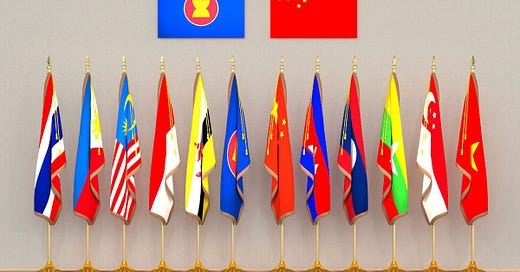SPECIAL | Why China-ASEAN Industrial and Supply Chains Matter?
China and the Association of Southeast Asian Nations (ASEAN) together account for over one-fifth of the global economy, and their industrial and supply chain cooperation has been growing stronger.
Editor’s Notes: From both production and consumption perspectives, China and ASEAN are forming a closer industrial chain. Facing the tariffs turbulence, China and ASEAN’s deep integration of the industrial chain, supply chain, and technical cooperation have enhanced Asia's position in the global economy.
At the Youyiguan Port (友谊关) on the China-Vietnam border, trucks from China and Southeast Asian countries, especially Vietnam, line up for customs clearance. Tropical agricultural goods like durians and mangosteens and other manufactured products from ASEAN countries enter the Chinese market here, while trucks loaded with electronic components and large-scale mechanical equipment head towards ASEAN countries. This bustling port is a microcosm of the thriving China-ASEAN industrial and supply chain.
China and ASEAN together account for over one-fifth of the global economy, acting as a crucial engine for global and regional economic development, especially when the global economy is buffeted by U.S.-imposed tariffs. China, as the only country in the world that has all the industrial categories based on the industrial classification of the UN, comprising 41 large, 207 medium, and 666 small industrial categories, is a strategic partner to ASEAN's industrial chain upgrading.
A report titled "RCEP and the Vision of the Maritime Silk Road: New Frontiers for China-ASEAN Cooperation" quoted official data that the zero-tariff coverage rate between China and ASEAN has remained above 65 percent. In 2024, bilateral trade in goods reached $982.34 billion, marking a year-on-year growth of 7.8 percent. In particular, trade in intermediate goods between China and ASEAN has risen to 67 percent of total trade volume since the Regional Comprehensive Economic Partnership (RCEP) entered into force, which indicates the formation of a more closely integrated and resilient production and supply chain network between the two sides.
China's investments in ASEAN further fuel this synergy. The Malaysia-China Kuantan Industrial Park and the China-Malaysia Qinzhou Industrial Park, co-built by China and Malaysia, have set an innovative example of bilateral economic cooperation under the "Two Countries, Twin Parks" model. In Thailand, Chinese automakers like Great Wall Motor set up R&D hubs and assembly plants, collaborating with Thai rubber and electronics industries to develop EV components for the global market.
According to China's Ministry of Commerce, bilateral trade between China and major ASEAN countries such as Vietnam, Malaysia, Indonesia, Thailand and Singapore has each exceeded $100 billion. China has been ASEAN's largest trading partner for 15 consecutive years, and ASEAN has been China's largest trading partner for four straight years.
With the synergy of the Belt and Road Initiative and the RCEP, the regional industrial and supply chains between China and ASEAN will be further integrated. The global pursuit of diversified and resilient supply chains makes the China-ASEAN cooperation more significant, creating growth opportunities for businesses.
Whether in production or consumption, the two sides are forging an ever-closer industrial chain, and the China-ASEAN Free Trade Area stands as a prime example of the importance of free trade in promoting integration.
Stay tuned for more updates on China's political, economic and cultural landscapes.
Disclaimer: This newsletter is for informational purposes only. All sources are publicly available and subject to change.
Shen Shiwei’s Social Media Links
X: @shen_shiwei Facebook: Shen Shiwei






